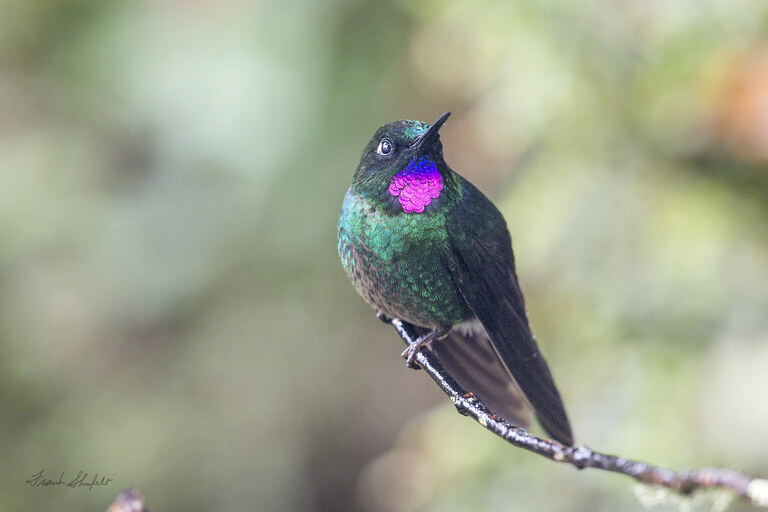
Order:
Apodiformes
Family:
Trochilidae
A beautiful hummingbird that attracts the attention thanks to its bright neck and its cute name (Tourmaline Sunangel). But don’t be fooled by appearances, this little friend is really territorial and aggressive, this is why has a peculiar name in colombia that does justice to its personality, “colibri belicoso” that means bellicose hummingbird.
Description
a large hummingbird that messures about 10.2cm, has short, straight beak about 1.5cm long. The male has a green back and chest, an iridescent blue gular zone, and a large bright pink patch on the lower throat. The tail is long and forked with conspicuous white undertail feathers and green central rectrices. The female has a green back and an iridescent green breast and forehead. The throat, the undertail feathers and the belly are white.
Distribution
It is found in the Andes from Colombia to Ecuador, from 1500 to 3900 m.
Habitat
prefers humid forest and cloud forests, likes open areas and forest edges, it is common to see it between bushes or grassland fulled with scrubs
Feeding
It feeds mainly on the nectar of Salvia and Fuchsia flowers. It also incorporates insects into its diet, which it captures on the fly or on the surface of plants.
Breeding
The female lays two eggs the size of a coffee bean between March and August
Behavior
It regularly flies at low altitudes in open areas such as forest edges. Like other species of the genus, when it perches, it leaves the wings open and when they extract the nectar from the flowers, it hangs from them with the wings arranged in a “V” shape.
Taxonomy
Previously it was proposed to unite Heliángelus exortis and Heliángelus micraster under a single species. As a result, they remained in the subspecies categories, Heliangelus exortis exortis for the Colombian populations and Heliangelus exortis micraster for the Peruvian and Ecuadorian populations. However, studies in recent years agree that the evidence of conspecificity between exortis and micraster is very weak, so they should be considered as different species.
Conservation status
It is classified as a species of least concern
Vocalization/ Song
https://www.xeno-canto.org/373181
References
https://www.icesi.edu.co
http: //avibase.bsc-eoc.org
https://birdscolombia.com








